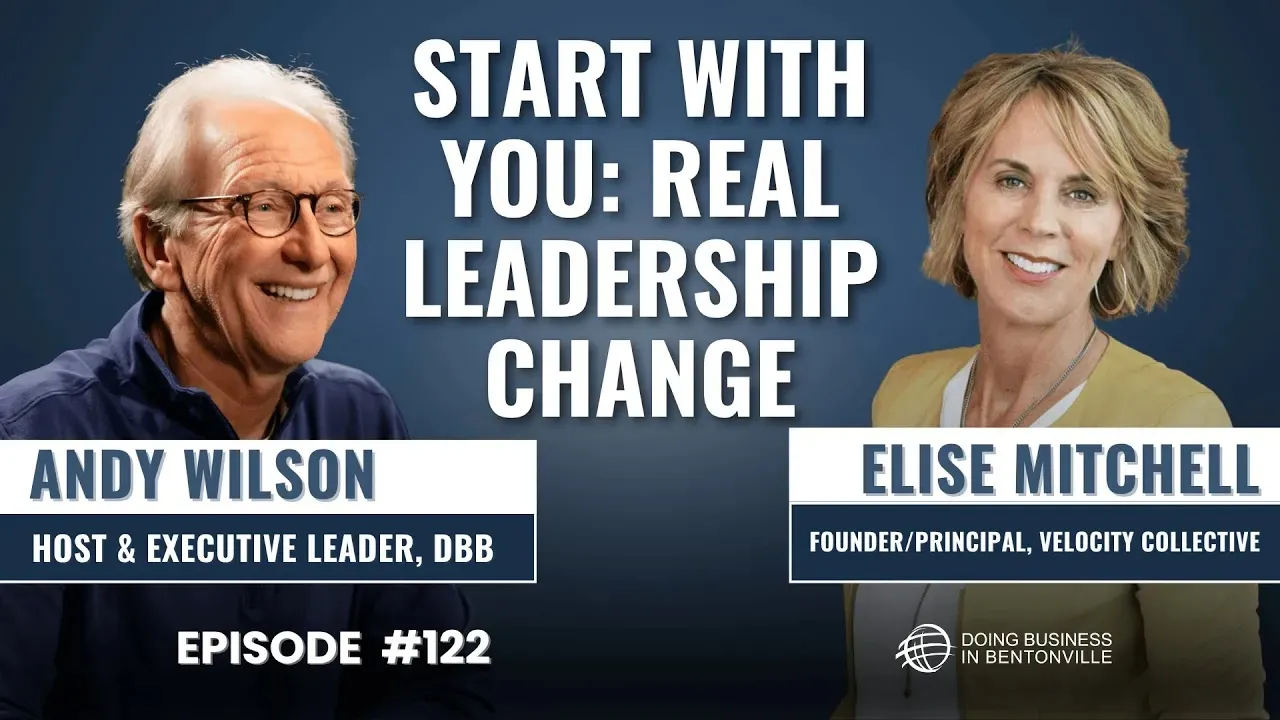Change doesn’t wait for us to feel ready, and that’s exactly where real leadership begins. Andy sits down with Elise Mitchell, CEO-turned-coach and bestselling author of Leading Through the Turn, to unpack seven hard-earned principles for guiding teams through uncertainty without losing your grip on what matters. From a personal “intervention” during hypergrowth to an unforgettable motorcycle lesson about focus and risk, Elise shows how to balance realism with optimism and keep your eyes on the line you want to exit.
We dig into accepting reality as the gateway to progress, making decisive calls when data is incomplete, and communicating in a way that creates context, connects the dots, and builds confidence. Elise goes deep on fear, fear of failure, of losing control, of not having every answer, and explains why courage must come before confidence. You’ll learn how to remove roadblocks that slow change, including the uncomfortable moment when the leader is the roadblock, and how to “ride loose” during people challenges so you can read the room, address conflict early, and stay present under pressure.
Then we shift to staying close to your people with genchi genbutsu, go and see. Get out of the tower, visit the frontline, praise effort as well as results, and create a culture of try where experiments are safe and learning beats perfection. Instead of rescuing, ask catalytic questions that return ownership to your team. Elise closes with practical cognitive tools, reprioritizing, distancing, identity-based motivation, and reframing, to help you manage yourself, show up as your ideal self, and keep momentum when the turn gets tight.
If you’re navigating change, leading a messy people problem, or just need a fresh dose of practical courage, this conversation will meet you where you are and move you forward. Subscribe, share with a leader who needs it, and leave a review with your top takeaway so we can keep bringing you conversations that sharpen your edge.
More About this Episode
Leading Through Change: 7 Leadership Principles to Inspire Resilience, Courage, and Clarity
Change is relentless.
In today’s fast-paced business environment, every leader is feeling it. Whether you're navigating a new strategic direction, restructuring a team, adapting to market shifts, or responding to external disruption, the ability to lead through change is not just valuable, it’s essential.
Over the years, working with leaders across industries and having built and sold my own firm, I’ve learned that leading through change isn’t just about strategy. It’s about mindset. It's about people. And most of all, it's about how we, as leaders, show up every single day, especially when the path forward is anything but clear.
What follows are seven deeply personal and practical leadership principles that I've learned the hard way, through real wins, painful failures, and some powerful wake-up calls. These aren’t abstract theories. They’re lessons from the trenches, insights that I hope will help you lead with more courage, clarity, and compassion through whatever changes you're facing.
1. Accept Reality So You Can Move Forward
The first principle of leading through change is deceptively simple: Accept what’s so.
As leaders, we often resist what’s right in front of us. We downplay the shift in market dynamics. We hope that a struggling strategy just needs more time. We avoid difficult truths because they’re uncomfortable or inconvenient. But change leadership starts with brutal honesty, with ourselves, and with our teams.
Acceptance isn’t the same as resignation. It’s the act of fully acknowledging the current reality so that we can make space for what’s next. Without this first step, any effort to transform your organization will be built on sand.
Instead of asking, “Why is this happening?” shift your perspective to “What’s the opportunity here?”
2. Be Decisive: Break Glass, Pull Handle
Change often feels like a firestorm. Decisions must be made quickly, with limited information, and under intense pressure. In these moments, hesitation can be costly.
I like to describe this principle as: Break glass, pull handle. It’s the emergency response mindset, a call to action when everything is at stake.
But being decisive doesn’t mean being reckless. It’s about developing discernment: learning how to trust your instincts, sift through noise, and make the best call with what you know today.
We discussed how leaders sometimes fall into "paralysis by analysis" or allow others’ opinions to sway critical decisions. Your team is looking to you to move. They need clarity. Even when the path is uncertain, forward momentum builds trust.
3. Connect the Dots and Create Clarity
People don’t just resist change; they resist change they don’t understand.
Once you've accepted reality and made initial decisions, it’s time to connect the dots for your team. This isn’t just about communicating what is happening. It's about explaining why, and painting a clear picture of the destination.
The best leaders don't rush ahead and expect others to follow. They create context: What brought us here? Where are we going? How do we get there?
Most importantly, they help each team member see how their work matters in this new future. People need to know that their contribution has an impact, that they are part of building something important.
And they need confidence that even if the road is bumpy, you’ll figure it out together.
4. Remove the Roadblocks, Starting with Yourself
Change doesn’t just test our strategies; it tests us.
In one of the most difficult seasons of my life, when my company was growing at an exponential rate, I became obsessed with performance. On the outside, we looked like a success story. Inside, I was running on empty. I was pushing my team relentlessly, convinced we had to be perfect to stay ahead.
Until one day, my own family confronted me. “Everyone still loves you,” my husband said, “but no one really likes you right now.”
That moment was my wake-up call. I was the roadblock.
When we talk about removing roadblocks during change, we often think about systems or resources. But more often than not, the greatest barrier is internal, our fear of failure, our need for control, our unwillingness to let go.
Fear is especially powerful during change. Fear of losing control. Fear of being overwhelmed. Fear of being exposed as not enough. But here’s the truth: Confidence doesn’t come first. Courage does.
Take the first step, even if you’re scared. That’s when the growth begins.
5. Toughen Up, Especially When It Comes to People Issues
If you lead people, you’ll face people's issues. Especially during times of transition.
Change stirs up fear, confusion, resistance, and doubt. And much of it will land squarely on your desk.
I used to think the best way to lead was to push harder. Then I learned an unexpected lesson on a motorcycle trip during a particularly rocky stretch of gravel road: the key to riding through rough terrain is to ride loose.
In leadership, this means softening your grip. Let go of the illusion of control. Stay alert, but not tense. Relax your posture. Be present. And ride through the bumps with grace.
When it comes to managing team challenges:
- Read the signals: Don’t just listen to what’s said, tune into what’s not being said.
- Address conflict early: Avoidance only multiplies complexity.
- Practice mindfulness: A few moments of presence can dramatically shift how you respond.
- Remember your resilience: You can take more than you think you can. You’ve done it before. You can do it again.
And one more thing: Don’t rush in to rescue people from discomfort. Growth lives there. Let them wrestle with the problem. Guide with questions, not answers.
6. Stay Close, Lead from the Front Lines
Leadership during change isn’t about disappearing into a tower and issuing memos. It’s about staying close.
One of the most powerful Japanese leadership principles I learned after selling my firm was Genchi Genbutsu, which means go and see for yourself.
Don’t assume. Don’t rely on filtered reports. Go to the front lines. Talk to customers. Sit in meetings. Observe the culture. Ask your team how things are really going.
Because when you stay close, you can:
- Understand what’s working (and what isn’t)
- Spot burnout before it becomes a crisis
- Celebrate effort, not just outcomes
- Invite team ownership and build trust
Change leadership isn’t about heroics; it’s about partnership. Don’t carry your team across the finish line. Teach them to carry themselves.
7. Always Give Your Best, Don’t Give Up
And finally, the hardest and most important principle: Always give your best.
There will be days you feel like quitting. Days when the decisions are impossible, the feedback is brutal, and the outcomes don’t match your effort. You’ll feel tired, beat up, and maybe even question whether you’re the right person for the job.
But remember this: leadership is an inner game. What sets great leaders apart is not their charisma, not their credentials, but their resilience.
Here are four mindset tools I use to stay grounded:
- Reprioritize: Ask yourself, “On a scale of 1 to 10, how big of a deal is this really?”
- Distance: Step back. Imagine how you’ll reflect on this moment one year from now.
- Define your ideal self: Who do you want to be in this challenge? Choose to show up that way—no matter what.
- Reframe the situation: What could you gain from this? What new meaning can you make?
There’s a reason I titled my book Leading Through the Turn. On a motorcycle, the most dangerous moments are in the turns, just like in leadership. But if you focus too long on the danger, you’ll veer off course. Instead, look where you want to go.
That's how you make it through.
The Journey Is the Destination
Leading through change is never easy. But it is worth it.
When we lead with clarity, courage, and compassion, we don't just help our teams survive transitions; we help them grow through them.
And in the process, we grow too.
So, if you're in the middle of a turn right now, personally or professionally, know this:
You don’t need all the answers. You just need to keep your eyes on where you want to go. Ride through the gravel. Stay close to your people. And never forget: the journey is the destination.










